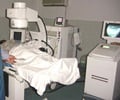- Two equations – The Modification of Diet in Renal Disease (MDRD) Study equation and the Chronic Kidney Disease Epidemiology Collaboration (CKD-EPI) equation – are commonly used to estimate the glomerular filtration rate in adults.
- New data suggests that the equations may not give accurate results in Indians due to the lower muscle mass and predominantly vegetarian diet as compared to the Americans, for whom they were developed.
- The introduction of a correction can improve the accuracy of the calculations.
Creatinine
Creatinine is produced naturally at a fairly constant rate by the body and the amount of creatinine in the body can be measured easily as a byproduct of muscle metabolism that is excreted unchanged in the kidney. It is an important indicator of kidney (renal) function.Creatinine gets removed from the blood primarily through glomerular filtration but is also actively secreted by the kidney tubules in very small amounts such that creatinine clearance overestimates actual GFR by 10% to 20%. None of the creatinine is reabsorbed.
Estimated glomerular filtration rate (eGFR)
The measured GFR (mGFR) is estimated by measuring the clearance of a substance called inulin from the blood. This process is, however, cumbersome and is not done in all centers.Instead, the estimated glomerular filtration rate (eGFR) is routinely used for the diagnosis and estimation of risk in chronic kidney disease as well as for the selection of live donors for kidney transplantation. It is calculated based on formulas that incorporate the creatinine clearance (CrCl, creatinine levels in the blood and urine) by the kidneys, the age, and sex of the individual.
If there is kidney dysfunction and the filtration is deficient, creatinine blood levels rise and the CrCl rate will overestimate the GFR because the active secretion will account for a larger fraction of the total creatinine cleared. Drugs like cimetidine, and trimethoprim reduce creatinine tubular secretion and, therefore, increase the accuracy of the GFR estimate. Hence, in the absence of secretion, creatinine behaves like inulin.
Pilot study to assess the existing eGFR calculators in Indians
The Chronic Kidney Disease Epidemiology Collaboration (CKD-EPI) equation is often preferred for the calculation. The formula has been developed using details from the North American Caucasian population with a correction later introduced for the Black population. To suit the Japanese, Chinese, Thai, Korean and Pakistani populations, correction factors have been applied or new equations have been developed. No such modification currently exists for the Indian community.In a pilot study, the scientists assessed the performance of the existing eGFR calculators based on creatinine or cystatin C clearance in 130 Indians, comprising of 63 healthy kidney donors and 67 suffering from chronic kidney disease. They compared the eGFR to the mGFR in individual patients. Around 50% of the individuals were vegetarians. The scientists found that:
- The creatinine-based eGFR calculations overestimated the GFR when compared to the mean mGFR
- The cystatin C based calculation of eGFR, which does not depend on the muscle mass or protein content of the diet, was not significantly different from the mGFR
The findings of the study have significant implications for healthy individuals being considered for kidney donation. If the creatinine-based equation is used, it will give a better estimation of the kidney function, which may not be as good.
It is, therefore, time to either develop a correction factor to the creatinine-based equations or develop a new equation to estimate the GFR accurately in the Indian population. Though the cystatin C test, which provides more accurate results, is a good alternative, a test that uses the measurement of creatinine has the advantage of being cheaper and more widely available.
The scientists do admit some shortcomings of the study, which include a small number of subjects, who were mainly North Indian, and the absence of a formal measurement of the muscle mass, which could have provided valuable information.
eGFR Estimation
Two equations are commonly used to estimate the glomerular filtration rate in adults – The Modification of Diet in Renal Disease (MDRD) Study equation and the Chronic Kidney Disease Epidemiology Collaboration (CKD-EPI) equation. The Bedside Schwartz equation is used in individuals less than 18 years.The MDRD equation is as below:
GFR (mL/min/1.73 m2) = 175 × (Scr)-1.154 × (Age)-0.203 × (0.742 if female) × (1.212 if African American)
Where Scr is serum creatinine in mg/dL,
The CKD-EPI equation is as below:
GFR = 141 × min (Scr /κ, 1)α × max(Scr /κ, 1)-1.209 × 0.993Age × 1.018 [if female] × 1.159 [if black]
Where:
- Scr is serum creatinine in mg/dL,
- κ is 0.7 for females and 0.9 for males,
- α is -0.329 for females and -0.411 for males,
- min indicates the minimum of Scr /κ or 1, and
- max indicates the maximum of Scr /κ or 1.
The equations are not recommended for use in patients with unstable creatinine concentrations, for example in acutely ill or hospitalized patients, or in those with extremes in muscle mass or diet, for instance, in bodybuilders or malnourished individuals.
Reference:
- Kumar V et al. Existing creatinine-based equations overestimate glomerular filtration rate in Indians. BMC Nephrology2018;19:22. https://doi.org/10.1186/s12882-018-0813-9
- National Institute of Diabetes and Digestive and Kidney Diseases - (https://www.niddk.nih.gov/)















